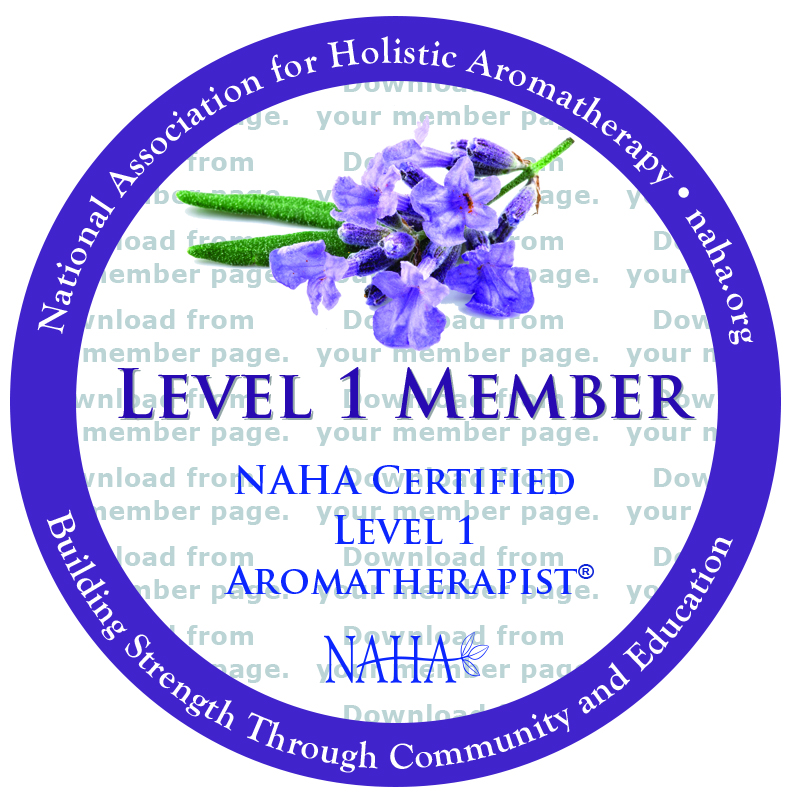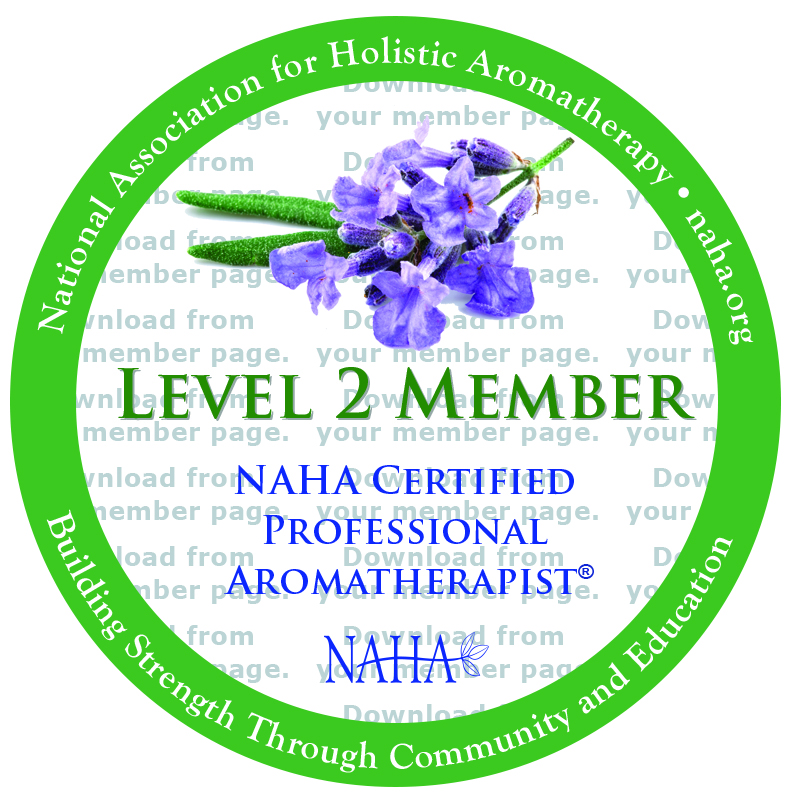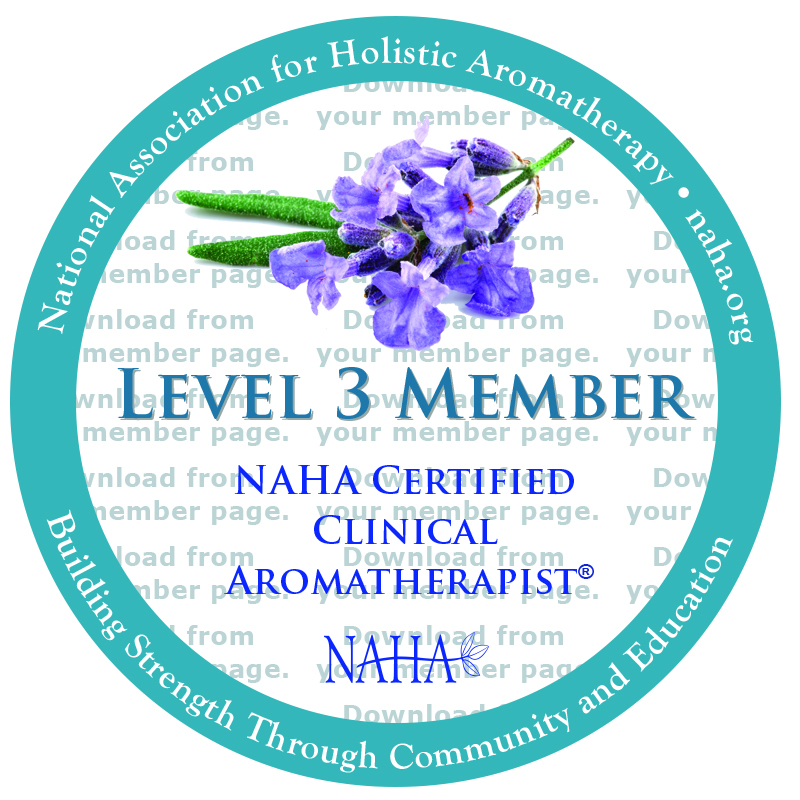Unsupported Browser
You are seeing this message because you are using the Internet Explorer web browser. Internet Explorer has not been updated with new features since the release of Windows 10 in July 2015, so it doesn't support the modern standards that our website uses. We recommend switching to Google Chrome, Mozilla Firefox, or Microsoft Edge, all of which our website is tested with.
Approved Standards for Professional Aromatherapy Education
Updated April, 2017 (approved schools have until January 1, 2018 to comply with the updated standards)
Note: NAHA considers plagiarism to be a serious offense. Plagiarism of materials would be grounds for termination of membership and immediate removal from the NAHA approved school list.
Level 1: NAHA Certified Level 1 Aromatherapist®

(Minimum 50 Hours* Curriculum)
• Introduction to the history of Aromatherapy
• Profiles of minimum 20 essential oils
• Minimum of 5 case studies
• Quality of essential oils
• Production and methods of extraction (distillation, cold pressing/expression, enfleurage, absolute, CO2 extraction)
• Basic physiological effects of essential oils: methods of absorption, overview of olfaction and the limbic system, the skin, and the immune system
• How essential oils interact on physical and emotional levels
• Basic essential oil chemistry with contraindications of certain essential oils
• How to create/design an effective blend
• Diluents such as vegetable oils and other carrier bases
• Methods of application (inhalation, diffusion, topical, optional: internal)
• Safety issues (including dermal, respiratory, internal)
• Legal, ethical, privacy issues (include a copy of the NAHA Code of Ethics)
*The Level 1 hour requirement applies to existing health professionals such as: Massage Therapists, Estheticians, Herbalists, Nurses, Physicians, etc. Students who are not existing health professionals have an additional requirement to provide proof of completion of Anatomy & Physiology 1 from an accredited institution, or the equivalent class taken from a NAHA approved school. Anatomy & Physiology Level 1 is a 3-4 credit undergraduate class which typically covers: Tissue & The Integumentary System; Skeleton, Joints & The Skeletal System; Muscle, Muscle Tissue & The Muscular System; Nervous Tissue & The Central Nervous System, The Peripheral Nervous System, The Autonomic Nervous System; The Endocrine System; Cellular Structure & Types, Basic Chemistry. Many universities and colleges offer this course in classroom and on line.
1 college credit = 15-16 classroom hours, or self-paced online which can often be completed more quickly.
Essential Oils Required for Level 1:
Clary Sage (Salvia sclarea), Cypress (Cupressus sempervirens), Eucalyptus (Eucalyptus globulus), Geranium (Pelargonium graveolens), Lavender (Lavandula angustifolia), Lemon (Citrus x limon), Peppermint (Mentha x piperita), Roman Chamomile (Anthemis nobilis), Rosemary (Rosmarinus officinalis), Sweet Orange (Citrus sinensis), Tea Tree (Melaleuca alternifolia), Ylang Ylang (Cananga odorata); 8 more essential oils chosen by the instructor for a total of 20.
Students should be made aware of the endangered or threatened status of essential oils such as: Agarwood (Aquilaria sp.), Frankincense (Boswellia carteri), Rosewood (Aniba rosaeodora) and Sandalwood (Santalum album).
1. Required elements for Level 1 student graduation based upon approved standards in aromatherapy education
1.1 Student must complete a minimum of 5 case studies.
1.2 Student must sit for and pass a Level 1 examination offered by the school.
1.3 Graduates must submit proof of completion of 5 NAHA approved continuing education hours (CEs) per year or 10 CEs every 2 years in order to remain a Level 2 member in good standing. Examples of NAHA approved CEs include: NAHA Conference, NAHA Webinars (free for members!), writing articles for the NAHA Journal, electives and continuing education courses taught by a NAHA approved school, volunteer or mentorship time spent in a holistic healing center that utilizes aromatherapy.
Level 2: NAHA Certified Professional Aromatherapist®

(Minimum 200 Hours** Curriculum)
• History and Modern Development
• Profiles of minimum 40 essential oils
• Minimum of 10 case studies
• Quality of essential oils
• Production and methods of extraction (distillation, cold pressing/expression, enfleurage, absolute, CO2 extraction)
• The basics of botany (specifically taxonomy)
• Organic chemistry
• Properties of essential oils within a holistic and professional framework
• Blending techniques
• Diluents such as vegetable oils and other carrier bases
• Methods of application (inhalation, diffusion, topical, optional: internal)
• Safety issues (including dermal, respiratory and internal use)
• Consultation and client education program design
• The basics of business development
• Legal, ethical, privacy issues (include a copy of the NAHA Code of Ethics)
**150 hours in addition to the required Level 1 hours, for a total minimum of 200. The Level 2 hour requirement applies to existing health professionals such as: Massage Therapists, Herbalists, Nurses, Physicians, etc. Students who are not existing health professionals have an additional requirement to provide proof of completion of Anatomy & Physiology 2 from an accredited institution, or the equivalent class taken from a NAHA approved school. Anatomy & Physiology Level 2 is a 3-4 credit undergraduate class which typically covers: The Reproductive System; The Cardiovascular System; The Lymphatic System & The Immune System; The Urinary System; The Digestive System. Many universities and colleges offer this course in classroom and on line.
1 college credit = 15-16 classroom hours, or self-paced online which can often be completed more quickly.
Prerequisites: All Level 1 requirements
2. Required elements for Level 2 student graduation based upon approved standards in aromatherapy education
2.1 Student must complete a 5-10 page research paper (pertaining to an aromatherapy topic).
2.2 Student must complete a minimum of 5 case studies in addition to the required level 1 case studies for a total minimum of 10.
2.3 Student must study a minimum of 20 essential oil profiles in addition to required Level I essential oils for a total minimum of 40.
2.4 Student must sit for and pass a Level 2 examination offered by the school.
2.5 Graduates must submit proof of completion of 10 NAHA approved continuing education hours (CEs) per year or 20 CEs every 2 years in order to remain a Level 2 member in good standing. Examples of NAHA approved CEs include: NAHA Conference, NAHA Webinars (free for members!), writing articles for the NAHA Journal, electives and continuing education courses taught by a NAHA approved school, volunteer or mentorship time spent in a holistic healing center that utilizes aromatherapy.
2.6 Professional liability insurance is recommended.
Level 3: NAHA Certified Clinical Aromatherapist®

(Minimum 300 Hours*** Curriculum)
Level 3 curriculum should prepare health professionals to proficiently practice aromatherapy in clinics that utilize complementary modalities (e.g., holistic healing centers, integrative medicine clinics, private practice).
• Profiles of minimum 50 essential oils
• Minimum of 20 case studies
• Properties of essential oils within a clinical framework
• Safety and toxicology of essential oils (topical and internal)
• Safety guidelines for vulnerable populations (infants & children, pregnant women, elderly, those with chronic health conditions)
• Client/patient intake or SOAP notes
• Scope of practice
• Legal, ethical, privacy issues (include a copy of the NAHA Code of Ethics)
• As long as the core requirements are met, curriculum may be developed in specific tracks or emphasis chosen by the instructor (e.g., aromatherapy for children, the elderly, women’s health, phyto-aromatherapy, dermatology, acupuncture, animal aromatherapy, compounding of clinical preparations, etc.) Graduates should accurately declare their qualifications in their biographies or resumes, and should avoid acting outside their scope of practice.
• Level 3 electives and continuing education classes may cover specific areas of interest chosen by the instructor.
***100 hours in addition to the required Level 1 & Level 2 hours, for a total minimum of 300. The Level 3 hour requirement applies to existing clinicians (Physicians, Nurses, Acupuncturists, Medical Herbalists, etc). Students who are not existing clinicians have an additional requirement to provide proof of completion of Advanced Pathophysiology from an accredited institution, or the equivalent class taken from a NAHA approved school. Advanced Pathophysiology is a 4 credit graduate level class which typically advances knowledge of anatomy and physiology while expaining the mechanisms of diseases and pathophysiological conditions affecting the the integumentary system, the circulatory system, the reproductive system, the musculoskeletal system, the lymphatic/immune system, the endocrine system, the nervous system, the urinary system, and the digestive system. Many universities and colleges offer this course in classroom and on line.
1 college credit = 15-16 classroom hours, or self-paced online which can often be completed more quickly.
Prerequisites: All Level 1-2 requirements
Level 3 graduates must have a minimum of 1 year of direct clinical aromatherapy experience before applying for Level 3 Membership.
3. Required elements for Level 3 student graduation
3.1 Student must complete a minimum of 10 additional case studies in addition to the required level 1 & 2 case studies for a total minimum of 20.
3.2 Student must study a minimum of 10 essential oil profiles in addition to required Level I & 2 essential oils for a total minimum of 50.
3.3 Student must sit for and pass a Level 3 examination offered by the school.
3.4 Graduates must be actively teaching or practicing clinical aromatherapy in order to remain a Level 3 member in good standing.
3.5 Graduates must submit proof of completion of 15 NAHA approved continuing education hours (CEs) per year or 30 CEs every 2 years in order to remain a Level 3 member in good standing. Examples of NAHA approved CEs include: NAHA Conference, NAHA Webinars (free for members!), writing articles for the NAHA Journal, electives and continuing education courses taught by a NAHA approved school, volunteer or mentorship time spent in a holistic healing center that utilizes aromatherapy.
3.6 Graduates must supply proof of professional liability insurance in order to remain a Level 3 member in good standing.
Companies that insure aromatherapists:
www.locktonmedicalliabilityinsurance.com (NAHA Member group discount)
As the aromatherapy industry evolves and develops to meet more integrative holistic health practices, as a leading organization in the aromatherapy field, we review our education standards from time to time to keep current, relevant and safe. It is recommended for you, as an advocate, student and/or educator, that you review our standards of education periodically to stay familiar and abreast of existing and new guidelines.
NAHA does not provide an approval process to review additional massage therapy programs (this should be done so via the NCBTMB (National Certification Board for Therapeutic Massage and Bodywork) and or with the individual Massage Therapy Boards in your State/Country). Any hours pertaining to actual massage therapy do not to count towards the NAHA education standards required hours (except for those that apply to safety in regards to topical application).
Precautionary measures should be taken with all application methods taught and practiced. Certain essential oils are unsuitable for undiluted application on the skin, or contain constituents which may irritate or sensitize the skin if applied without first being properly diluted in a carrier. NAHA does not support the use or application of "drop therapies" which utilize undiluted dermal sensitizing essential oils. Educational curriculums that includes excessive amounts of essential oils applied undiluted to the skin will not be accepted as part of any school application and is not part of the overall NAHA education standards. In addition, student case studies submitted as part of their graduation requirement that include improper undilution of essential oils, will not be accepted.
Case Study Writing Guidelines
1) Identify the client’s chief complaints.
2) Summarize the client’s background, relevant facts, and any key factors leading to the current complaints.
3) Formulate a thesis statement.
4) List your aromatherapy recommendations for the client.
5) Demonstrate that you have researched your recommendations for the client and/or explain your reasoning for choosing specific essential oils and any other recommendations.
6) Explain any constraints and recommend alternatives (e.g., alternatives to oils that are out of budget, allergies, sensitivities, personal preferences of the client).
7) After following your client for a minimum of 3 months, summarize your client’s outcome. Include details on compliance, any improvements, set-backs or challenges that your client experienced. (Case studies for acute conditions may also be included as long as the majority of your case studies represent clients followed for a minimum of 3 months.)
8) Summarize your action plan for the future.
Research Paper Writing Guidelines
1) 5-10 pages typed and double spaced.
2) 12 point Times New Roman, Ariel, Bookman or Courier Font.
3) Data and evidence must be quality and of logical reasoning.
4) Choose an aromatherapy related topic.
5) Research information about your topic.
6) State your thesis.
7) Organize your research notes.
8) Create an outline.
9) Include references at the end of your paper (note that plagiarism is a serious offense and will be grounds for failure). Good information on citing references in scientific research papers can be found here: http://tim.thorpeallen.net/Courses/Reference/Citations.html
10) Type your rough draft.
11) Optional: Ask a fellow student or colleague to proof read your rough draft for you.
12) Type your final draft and submit it to your instructor.
13) Optional: Once your final draft has been accepted by your instructor, submit a copy to NAHA for possible publication in the NAHA journal.
14) Aromatherapy trade journals, herbal associations, and research links:
- NAHA Journal: www.naha.org (log into your member page to view)
- International Journal of Aromatherapy: www.essentialorc.com/resources
- International Journal of Professional Holistic Aromatherapy: www.ijpha.com
- International Journal of Clinical Aromatherapy: ijca.net
- The Aromatherapy Thymes: www.aromatherapythymes.com
- Aromatherapy Today: www.aromatherapytoday.com
- Aromatika Magazine: aromatika.hu
- Aroma Culture Magazine: www.aromaculture.com/the-magazine
- American Botanical Council: http://abc.herbalgram.org/
- PubMed: http://www.ncbi.nlm.nih.gov/pubmed/
- Science Direct: http://www.sciencedirect.com/
- Journal of Botanical Sciences: http://www.rroij.com/botanical-sciences.php
- HerbMed: http://www.herbmed.org/
- American Herbalists Guild: http://www.americanherbalistsguild.com/
- The Plants Database: http://plants.usda.gov
- Dr. Duke's Phytochemical and Ethnobotanical Databases: http://www.ars-grin.gov/duke/chem-activities.html
15) Safety guidelines:
- NAHA: http://naha.org/explore-aromatherapy/safety
- Essential Oil Safety: A Guide for Health Care Professionals, 2nd Edition by Robert Tisserand and Rodney Young. Available for purchase from the NAHA book store: www.naha.org/bookstore
Anatomy & Physiology, Pathophysiology Training Programs:
Some of our NAHA Approved Schools and many universities/colleges offer live and on line Anatomy & Physiology as well as Pathophysiology classes.
Stay Informed
Not a member yet but would like to stay up to date with NAHA? Considering joining but would like to explore the National Association for Holistic Aromatherapy more? Join our e-newsletter today and stay in touch.
Get in Touch
Our office hours are 9 am to 5 pm Mountain time, Monday - Friday.
National Association for Holistic Aromatherapy
6000 S. 5th AvePocatello, ID 83204
208-232-4911
Browse Our Content
Search the Site
Let's Get Social
Copyright © 2024 National Association for Holistic Aromatherapy. All rights reserved.
The National Association for Holistic Aromatherapy is a 501(c)3 non-profit association.
All material provided on this website is provided for informational or educational purposes only, and is not intended as a substitute for the advice provided by your healthcare professional or physician.